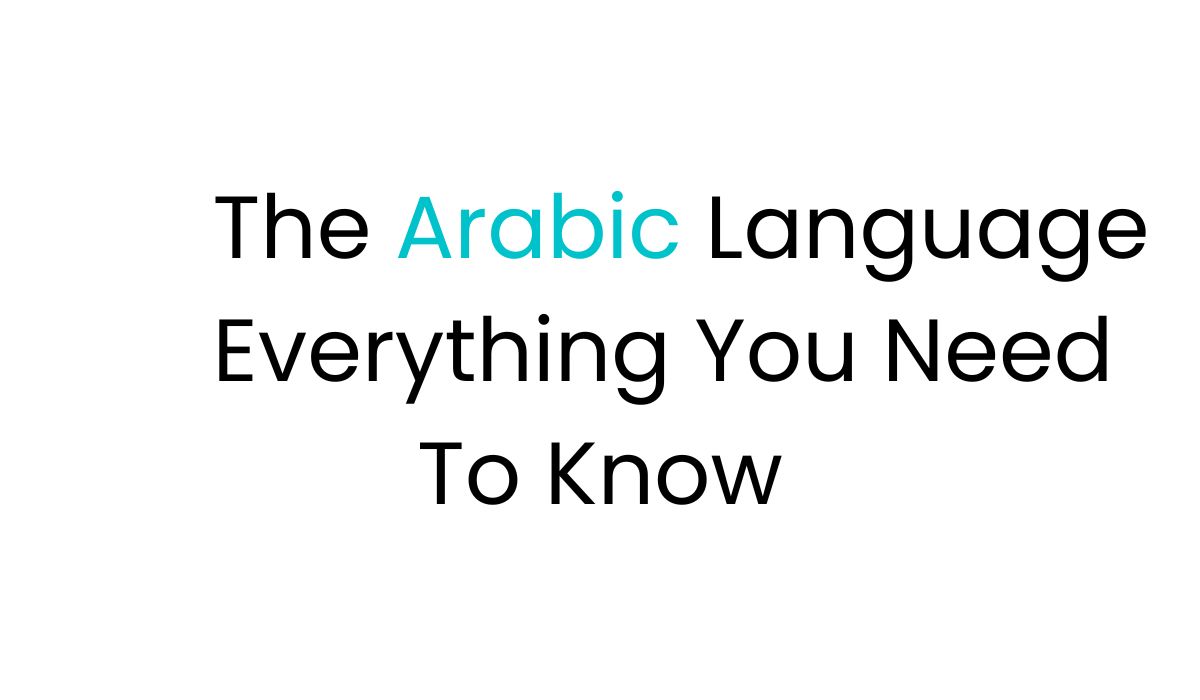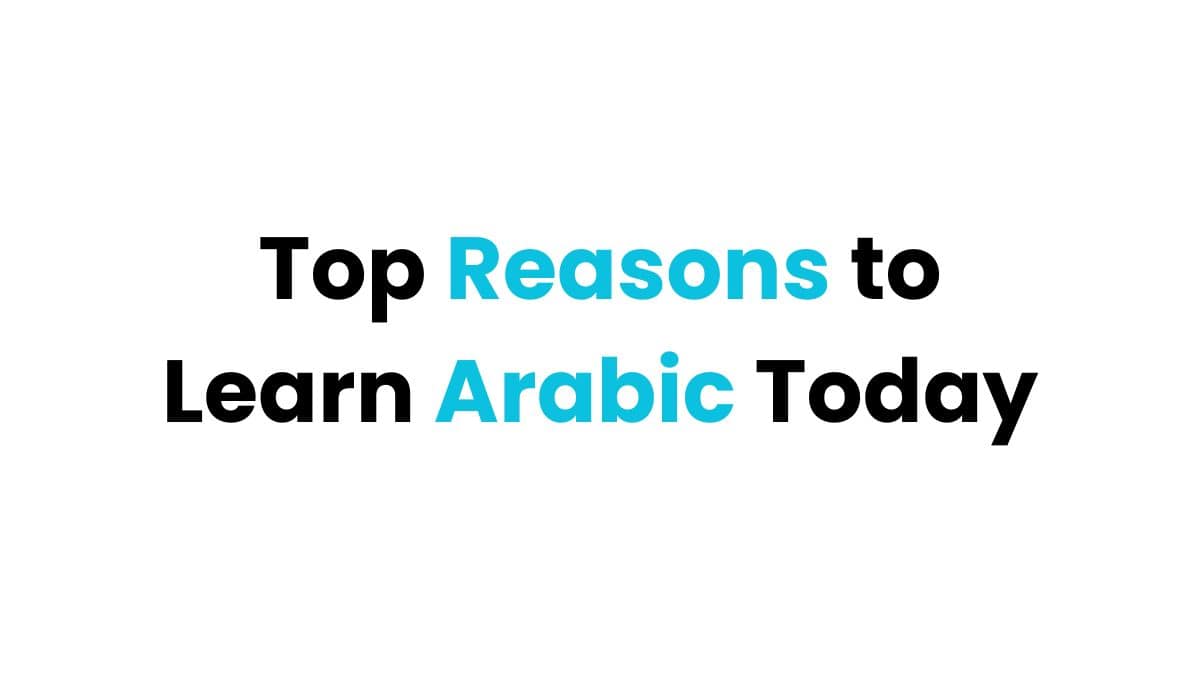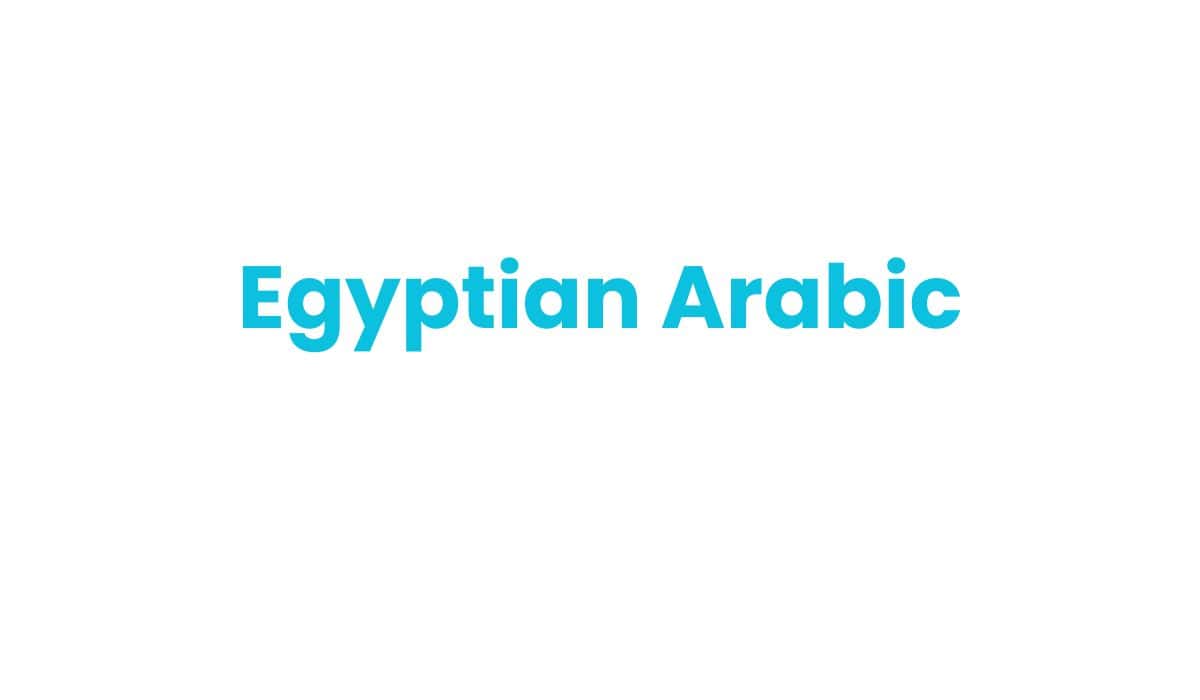Did you know Arabic has over 25 different dialects? These are spoken in 22 countries. It’s one of the most diverse languages worldwide. The dialects show a rich cultural tapestry, more than just talking.
The Arabic language’s diversity shows the complex history and culture of the Arab world. From Cairo’s busy streets to Lebanon’s coast, each dialect has its own story. It’s about how language and culture evolve together.
Arabic varieties show not just where people are from but also their history and society. People from different places can often understand each other, creating a unique language world. This world challenges old ideas about language.
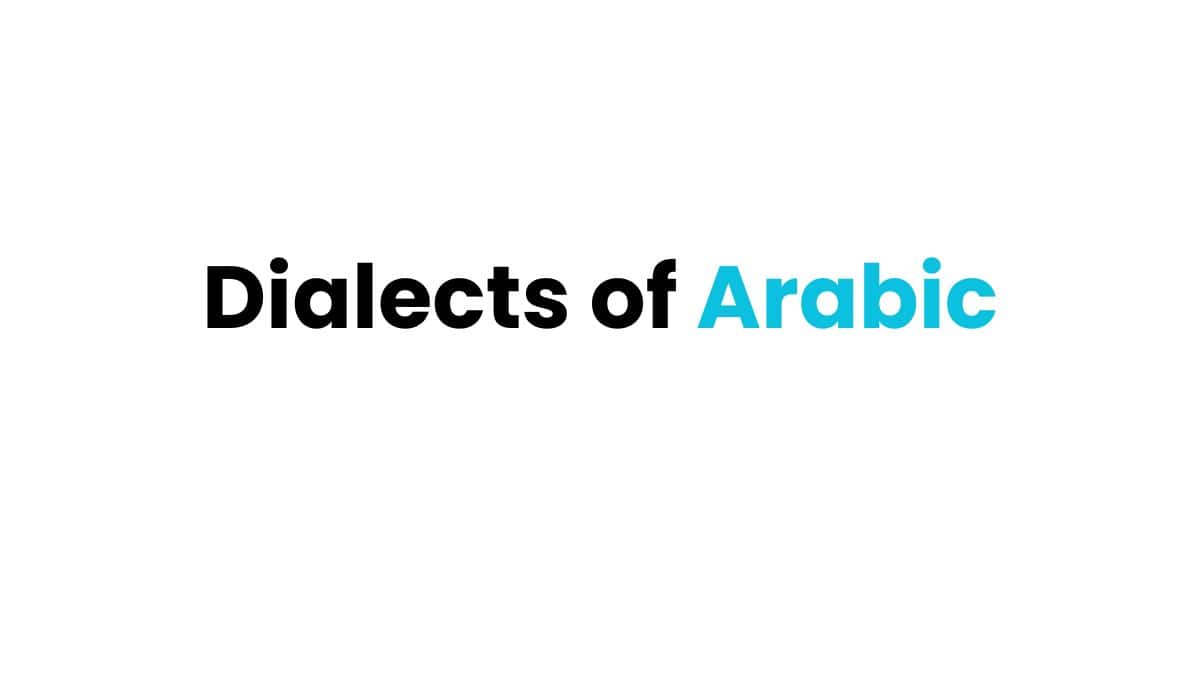
Key Takeaways
- Arabic has over 25 distinct regional dialects
- Language diversity reflects rich cultural heritage
- Dialects vary significantly across geographical regions
- Arabic is the 6th most widely spoken language globally
- Each dialect represents a unique cultural narrative
- Key Takeaways
- Origins and Historical Development
- Evolution of Semitic Languages
- Geographical Distribution
- Role in Education and Media
- Differences from Classical Arabic
- Global Significance of MSA
- Major Dialect Groups
- Geographical Distribution
- Cultural Influences
- Urban and Rural Dialect Variations
- Cultural Significance
- Distinctive Features
- Linguistic Composition of Moroccan Arabic
- Dialect Characteristics
- Learning Moroccan Arabic
- Social Media Influence
- Television and Film Industry
- Music and Cultural Expression
- Digital Transformation Impact
- Globalization and Language Dynamics
- Youth Language Patterns
- What are the main Arabic dialect groups?
- How different are Arabic dialects from Modern Standard Arabic (MSA)?
- Is it difficult to understand different Arabic dialects?
- What is diglossia in the Arabic language?
- Which Arabic dialect is the most widely spoken?
- Can I learn multiple Arabic dialects?
- How do Arabic dialects differ from Classical Arabic?
- What resources are available for learning Arabic dialects?
Understanding the Arabic Language Family
The Arabic language is a complex and rich tapestry. It is deeply rooted in the Middle East and North Africa. Arabic is part of the Afroasiatic language family, showing the diversity and history of languages.
Origins and Historical Development
Arabic linguistics has ancient roots. The earliest signs of Arabic were found in Nabataean inscriptions from the 3rd century BCE. Its evolution shows a journey of cultural exchange and historical change.
- Emerged from the Arabian Peninsula
- Developed through interactions with diverse cultures
- Influenced by trade, conquest, and religious expansion
Evolution of Semitic Languages
Arabic dialect studies show a complex network of language development. As a Semitic language, Arabic is connected to Hebrew and Aramaic. This highlights the intricate ties within the language family.
“Language is the roadmap of a culture. It tells you where its people come from and where they are going.” – Rita Mae Brown
Geographical Distribution
Arabic language diversity covers many regions. Each area has its own unique dialects:
- Maghrebi Dialects (North Africa)
- Egyptian Arabic
- Levantine Dialects
- Gulf Arabic
- Mesopotamian Dialects
With over 300 million native speakers, Arabic is a vibrant and dynamic language. It continues to evolve and meet the needs of modern communication.
The Journey of Arabic Script Development
The Arabic script has a long history, starting around 1900 BCE. It has changed a lot over the years, influenced by many cultures and events.
The script came from the Nabataean version of the Aramaic script. This was a key step in its development. Many studies and ancient texts support this origin.
- 28 graphemes make up the Arabic alphabet
- Two symbols (و and ى) can be consonants or long vowels
- The Qur’an is the only fully vocalized Arabic text
Arabic calligraphy has many styles, showing the culture’s richness. Some famous styles include:
- Kufic
- Naskh
- Thuluth
- Diwani
*The arabic writing system is more than a way to communicate – it’s a living art that connects people across time.*
Between the 4th and 6th centuries CE, the script evolved from Nabataean to modern Arabic. This time saw big improvements in the script, laying the groundwork for communication in many communities.
Now, the arabic script is used in many ways, including digital technology. It’s used by hundreds of millions, showing its importance in the world.
Modern Standard Arabic: The Formal Language
Modern Standard Arabic (MSA) is a key language that connects millions of Arabic speakers. It is a formal language that goes beyond local dialects and cultural differences.
MSA is more than just a language. It is used by about 330 million people worldwide. This makes it a powerful tool for sharing culture and ideas.
Role in Education and Media
MSA is very important in many areas:
- It is the official language in 27 countries in the Middle East and North Africa.
- It is the main language used in schools.
- It is the standard for news and print media.
- It is the official language of the United Nations.
Differences from Classical Arabic
MSA has its roots in classical Arabic but has changed over time. It is more open to new words and ideas than classical Arabic. This makes it better for talking about modern things.
“Modern Standard Arabic bridges historical linguistic heritage with contemporary global communication needs.”
Global Significance of MSA
MSA is important for more than just talking. It helps Arabic-speaking people feel connected, no matter where they are.
- It is used in diplomatic talks.
- It is the main language for scientific papers.
- It is key for international business.
- It helps people understand each other better.
MSA is a powerful language that brings people together. It keeps growing and changing, staying important in our world.
Classical Arabic: The Language of Heritage
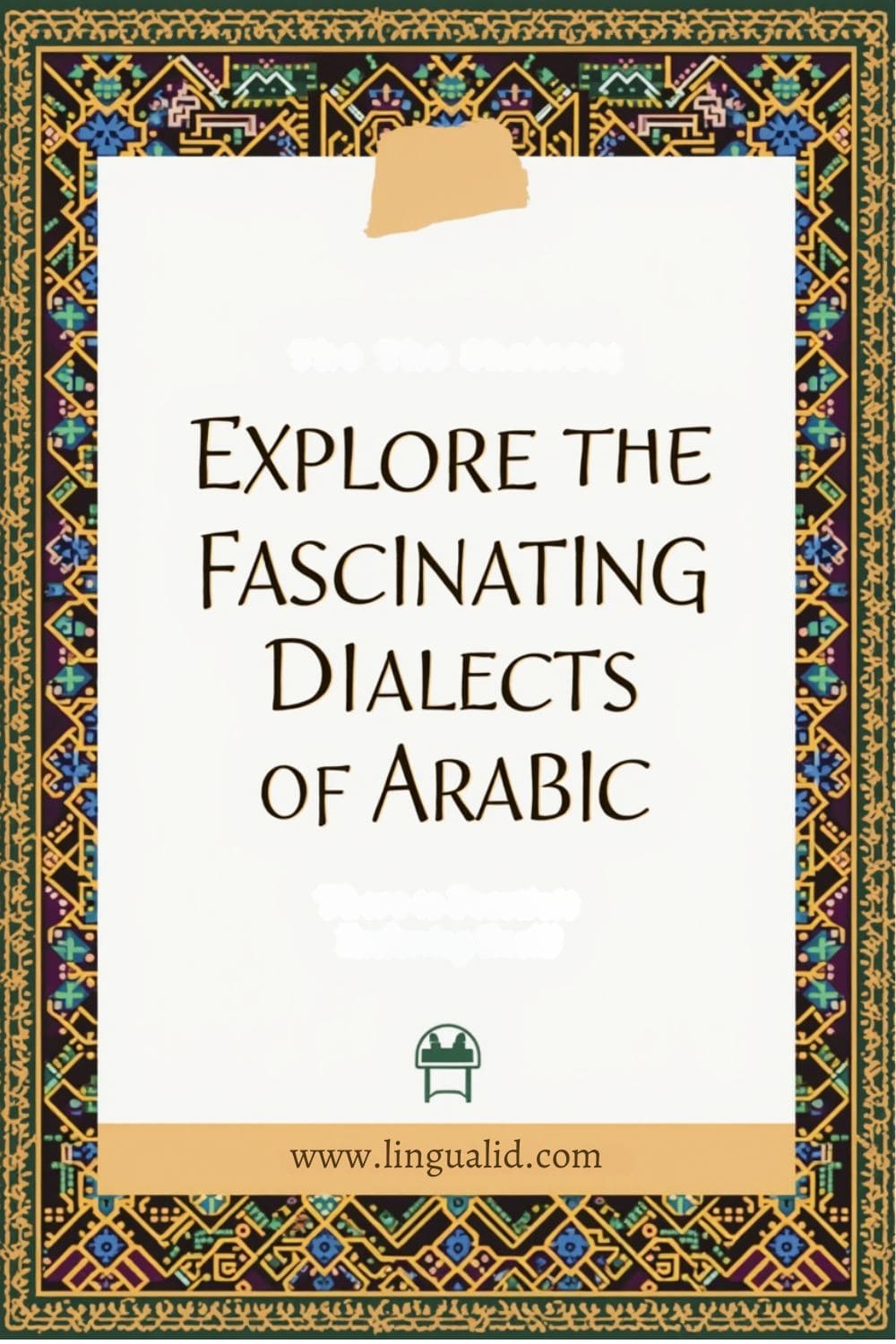
Classical Arabic is a deep treasure of language, showing the purest Arabic form. It’s deeply connected to arabic heritage. It’s used for religious texts, scholarly works, and traditional literature.
This language is more than just a way to talk. It connects us to Islamic civilization’s culture and spirit.
The beauty of quranic arabic is its preservation of pure language. Experts see classical arabic as a key to the Arab world’s rich history. It keeps complex grammar and words that show centuries of culture.
- Used primarily in religious contexts
- Foundation for religious and historical texts
- Preserved through scholarly and literary traditions
- Critical for understanding Islamic literature
Classical arabic has special features:
| Feature | Description |
|---|---|
| Grammar | Complex case endings and flexible word order |
| Vocabulary | Archaic terms specific to ancient poetry and religious texts |
| Historical Origin | Predates Islam, with roots in pre-Islamic poetry |
“Classical Arabic is not just a language, but a living archive of cultural memory.”
Even though it’s not spoken today, classical arabic is key for studying religion and culture. It’s studied by those who want to understand the Arab world’s language heritage. They keep its beauty and history alive.
Dialects of Arabic: A Regional Overview
Arabic is a rich and diverse language with many regional dialects. These dialects show the cultural richness of Arabic-speaking areas. With over 420 million native speakers in 28 countries, they weave a colorful tapestry of communication and culture.
The different Arabic varieties are shaped by history, geography, and culture. Each dialect has its own story, reflecting local traditions and historical experiences.
Major Dialect Groups
Arabic dialects fall into several main groups:
- Egyptian Arabic: The most widely understood dialect
- Levantine Arabic: Spoken in Syria, Lebanon, Jordan, and Palestine
- Gulf Arabic: Common in Arabian Peninsula countries
- Maghrebi Arabic: Used in North African nations
- Mesopotamian Arabic: Spoken in Iraq
- Sudanese Arabic: Unique to Sudan
Geographical Distribution
The spread of Arabic dialects mirrors the complex social and cultural scene of the Arabic world. Egypt has the most Arabic speakers, with 100,000,000. Algeria comes second, with 40,100,000 speakers.
Cultural Influences
Each dialect has its own unique features, shaped by local languages and history. Levantine Arabic has French and Turkish influences. Maghrebi dialect includes French, Spanish and Amazigh words, showing the ever-changing nature of these languages.
“Language is the road map of a culture. It tells you where its people come from and where they are going.” – Rita Mae Brown
Egyptian Arabic: The Most Widely Spoken Dialect
Egyptian Arabic, known as Masri locally, is the most spoken Arabic dialect worldwide. It has about 103 million speakers. This dialect is key for communication across the Arab world.
Its wide reach comes from several factors:
- Extensive media influence through Egyptian cinema
- Significant population in Egypt
- Cultural prominence across the Middle East
“Egyptian Arabic is not just a language, but a cultural ambassador that bridges communities across the Arab world.”
Egyptian Arabic has unique traits that set it apart from Modern Standard Arabic. Some key features include:
- Pronunciation of “g” instead of classical “q”
- Vocabulary borrowings from Coptic, Turkish, French, and English
- Distinct phonetic patterns
The dialect’s language shows Egypt’s rich history and cultural diversity. It’s widely used, making it a common language for Arabic speakers everywhere.
| Dialect Characteristic | Description |
|---|---|
| Native Speakers | 78 million (2021) |
| Second Language Speakers | 25 million (2022) |
| Total Estimated Speakers | 103 million (2021-2022) |
Egyptian Arabic keeps changing, showing how language and culture evolve in the Arab world.
Levantine Arabic: The Eastern Mediterranean Voice
The Levantine Arabic, known as Shami locally, is a vibrant language in the Eastern Mediterranean. It’s spoken by about 54 million people. This dialect covers Jordan, Palestine, Syria, and Lebanon, showing a rich cultural mix.
Levantine Arabic has a long history. It started in the 7th century A.D. when Arabic replaced Syriac after the Muslim conquest.
Urban and Rural Dialect Variations
Levantine Arabic shows interesting differences between cities and countryside. Key points include:
- Urban dialects in cities like Beirut, Damascus, and Amman have more foreign influences
- Rural dialects keep more traditional Arabic words
- Words and sounds change a lot between cities
Cultural Significance
“Language is the road map of a culture. It tells you where its people come from and where they are going.” – Rita Mae Brown
The dialect is a strong cultural marker. It shows the area’s diverse ethnic groups. People like Samaritans, Circassians, Armenians, and Kurds speak it.
Distinctive Features
Levantine Arabic has special features:
- It has simpler grammar than Modern Standard Arabic
- It has many Aramaic words
- It also has words from Turkish, French, and English
- It has unique ways of saying things
In cities and villages, Levantine Arabic is a lively language. It connects millions in the Eastern Mediterranean.
Gulf Arabic: Traditions of the Arabian Peninsula
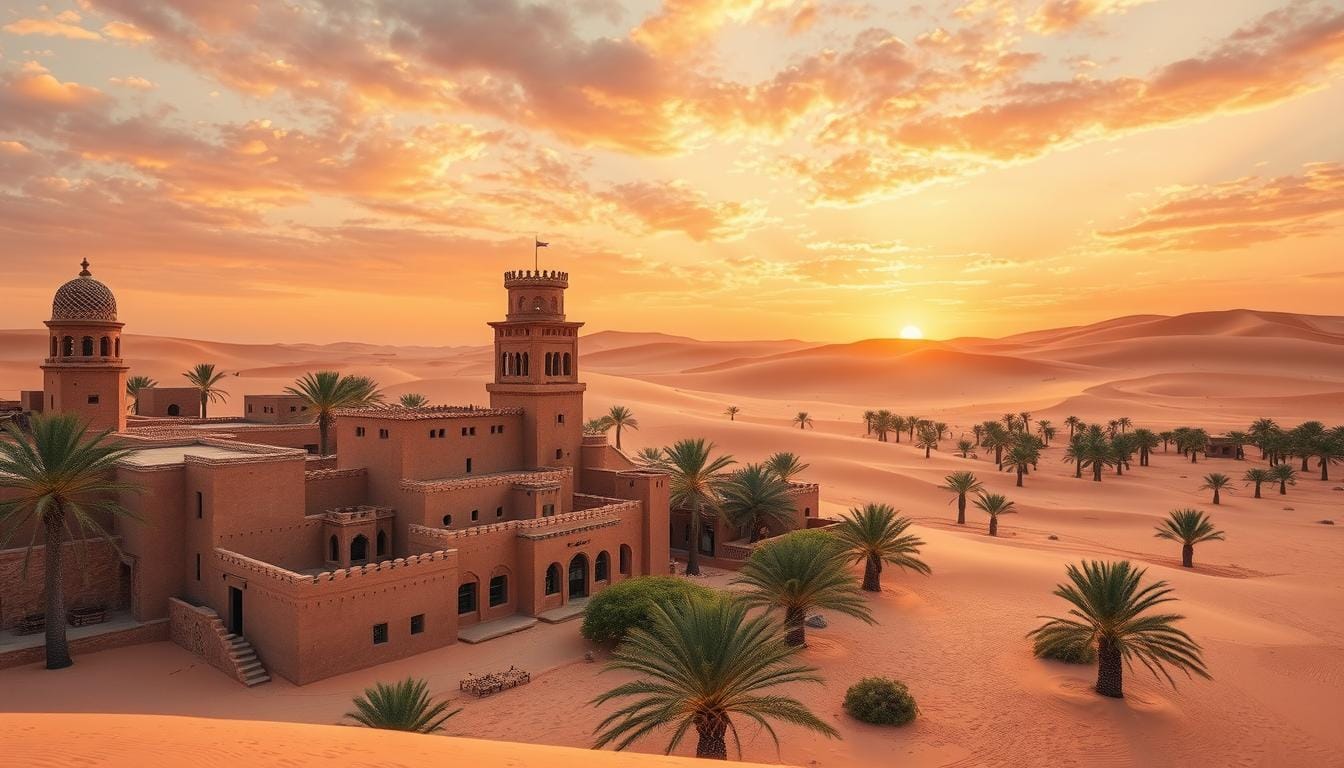
Gulf Arabic, also known as khaleeji, is a lively language tradition across the Arabian Peninsula. It covers the communication styles of Bahrain, Kuwait, Qatar, and the United Arab Emirates. This dialect is a key part of the region’s rich culture.
The Gulf Arabic dialect is known for its diversity. It has two main types:
- Badawī (Bedouin) – showing the traditions of nomadic people
- Ḥadarī (Sedentary) – showing the ways people talk in cities
About 11 million people speak Gulf Arabic. Most of them live in Eastern Arabia. This dialect has special sounds and ways of speaking.
- It keeps sounds that others don’t
- It has unique ways of saying vowels
- It changes consonants in special ways
“Gulf Arabic represents more than a language – it’s a cultural tapestry woven through generations of communication.”
The Gulf Cooperation Council, started in 1981, helps keep these traditions alive. Scholars say Gulf Arabic has changed over time, influenced by languages like Farsi and Turkish.
Peninsular Arabic is still strong, with about 77 million speakers from 2018-2023. Its ability to adapt shows its deep cultural importance and relevance today.
Moroccan Arabic: A Unique Blend of Influences
Moroccan Arabic, known as darija locally, is a fascinating mix of cultures. It shows the rich history and language of Morocco. This dialect is a key part of North African speech.
The Maghrebi Arabic dialect is special, mixing many languages. It’s spoken by about 29 million people as their first language. Another 9.6 million use it as a second language, making it a major way to talk in Morocco.
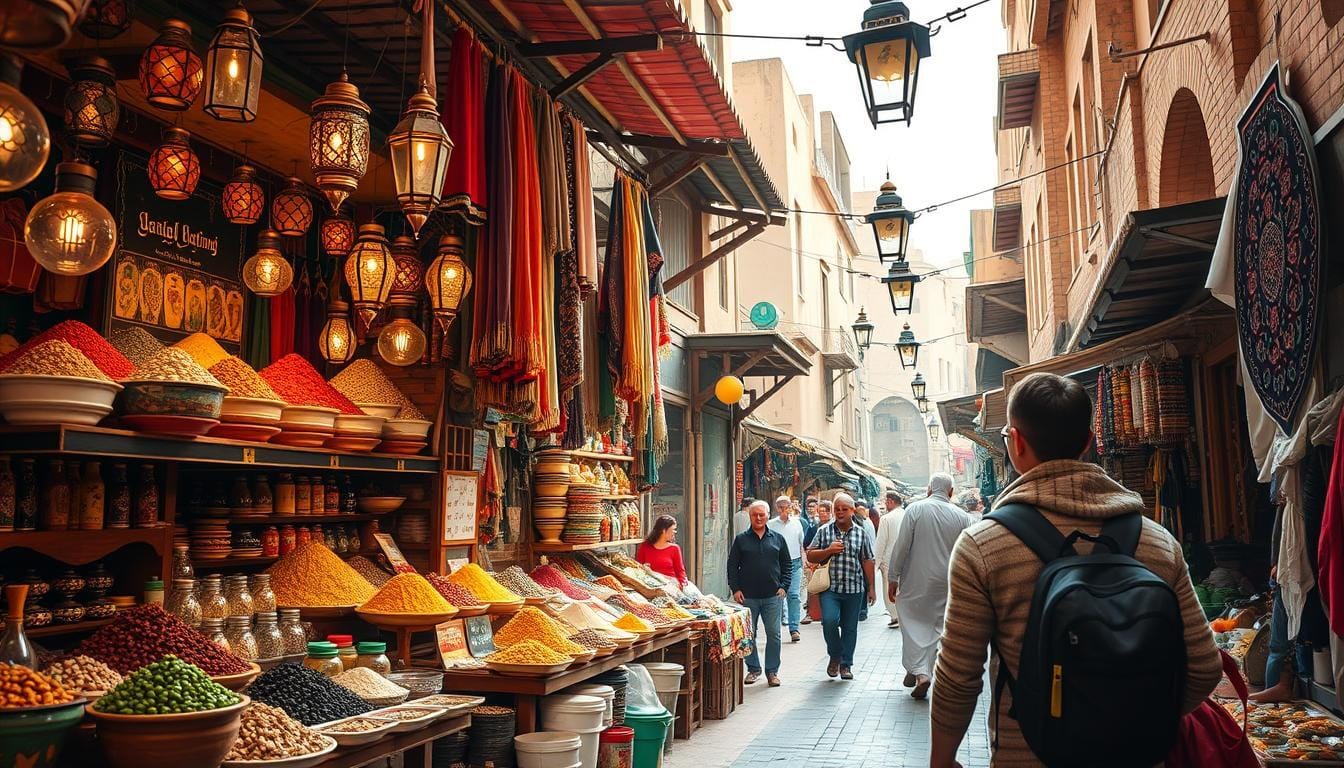
Linguistic Composition of Moroccan Arabic
Moroccan Arabic is very diverse in language. It includes:
- Amazigh languages
- Arabic classical roots
- French colonial influences
- Medieval Spanish contributions
Dialect Characteristics
The darija has its own sound and words. These make it different from other Maghrebi Arabic dialects. It’s also quite hard to learn.
| Language Influence | Impact on Moroccan Arabic |
|---|---|
| Amazigh Languages | Phonetic variations and vocabulary |
| French | Administrative and educational terminology |
| Spanish | Historical linguistic contributions |
Learning Moroccan Arabic
Our website helps people learn this beautiful dialect. We offer ways to understand Moroccan Arabic’s unique features.
“Moroccan Arabic is not just a language, but a living testament to Morocco’s rich cultural history.” – Oualid Cheddadi
Most of Morocco’s people, 90.9%, speak this lively dialect. It’s a big part of their identity and how they communicate.
Arabic Dialects in Modern Media and Entertainment
The world of arabic media has changed a lot lately. Dialects are key in showing our culture. Arabic entertainment lets us see the variety of languages and cultures through different media.
Social Media Influence
Social media is now a big place for dialects in pop culture. Creators use local languages to talk to people. This helps break down language barriers and celebrates different cultures.
- Influencers use local dialects to create relatable content
- Viral videos highlight regional linguistic differences
- Social media enables direct cultural exchange
Television and Film Industry
The arabic entertainment world knows how important real dialects are. Egyptian Arabic is very popular, with Egyptian shows seen everywhere. Producers use local languages to make stories more real.
| Dialect | Media Influence | Audience Reach |
|---|---|---|
| Egyptian Arabic | Highest media presence | Entire Arab world |
| Levantine Arabic | Strong regional representation | Syria, Lebanon, Jordan |
| Gulf Arabic | Growing international visibility | Gulf Cooperation Council countries |
| Moroccan Arabic | Growing international visibility | North Africa and Europe |
Music and Cultural Expression
Musicians play a big role in arabic media, using dialects to tell stories. Each regional dialect brings unique musical styles and emotional depth. This connects listeners to their culture and today’s world.
“Our dialects are not just languages; they are living, breathing narratives of our collective identity.” – Contemporary Arabic Music Critic
The Role of Arabic Dialects in Business Communication
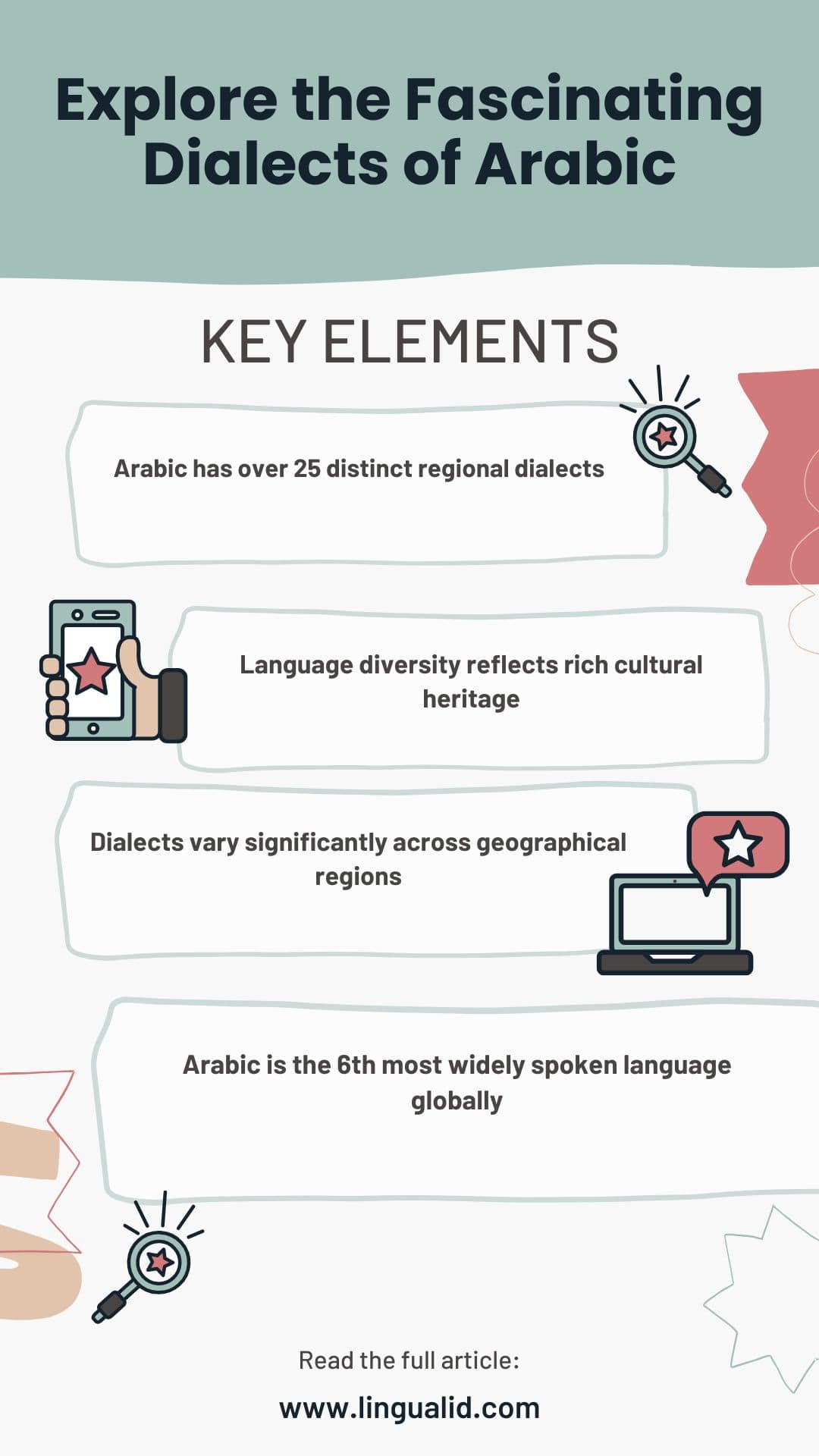
Understanding arabic for business is more than just knowing the language. It’s about diving into the world of regional dialects. These dialects are key in business talks across the Middle East.
Knowing dialects in commerce can really help international business pros. With about 319 million Arabic speakers worldwide, getting the hang of different dialects is a big plus.
- Egyptian Arabic: Most widely understood dialect in media and business
- Gulf Arabic: Crucial for oil and energy sector negotiations
- Levantine Arabic: Key for interactions in Syria, Lebanon, Jordan, and Palestine
- Moroccan Arabic: Essential for North African market engagement
Language is not just communication—it’s a bridge to cultural understanding. Business leaders who learn regional dialects show respect. They build stronger ties with local partners.
“In the Arab world, speaking the local dialect can transform a transaction into a genuine connection.” – International Business Expert
Here are some tips for using dialects in business:
- Know what locals prefer in communication
- Adjust your style to fit local norms
- Use professional translation services
- Get the cultural context, not just the words
Arabic is the fourth most sought-after language globally. Mastering its many dialects is a big business plus.
Preservation of Arabic Dialects in the Digital Age
The digital world offers new chances to save Arabic dialects and document the Arabic language. Arabic’s linguistic heritage faces big challenges in today’s fast-changing tech world. With only 3% of online content in Arabic, digital spaces are key for keeping language diversity alive.
“Technology is not just transforming communication, but becoming a vital tool for language preservation” – Digital Linguistics Research Center
Digital tools are becoming strong helpers in protecting Arabic dialects. New methods are changing how we save languages through several important ways:
- Creating online archives of dialects
- Developing advanced language recognition algorithms
- Creating interactive digital learning tools
- Helping languages from different regions work together
| Digital Preservation Metric | Current Status |
|---|---|
| Arabic Online Content | 3% |
| Arabic Global Internet Users | 5.2% |
| Total Arabic Speakers | 450 million |
Machine learning and artificial intelligence are changing how we save dialects. Researchers use advanced computer methods inspired by ancient Arabic scholars like Al-Kwarizmi and Ibn Al-Haytham. They helped start modern computer linguistics.
Future Trends in Arabic Dialect Evolution
The Arabic language is changing fast, thanks to digital tech, global connections, and new generations. These changes are making Arabic communication in the Arab world very different.
Digital Transformation Impact
Social media has changed how we talk. Here are some big changes:
- Emergence of Arabizi (Arabic written in Latin script)
- More switching between Arabic and English
- Fun ways to talk on TikTok and Instagram
Globalization and Language Dynamics
Global connections are mixing languages in new ways. Arabic dialects are getting influences from other languages, especially in cities. This mixing happens fast because of the internet.
Youth Language Patterns
Young people are leading in language trends. They mix dialects and try new ways to talk. This breaks old rules of language.
“Language is a living organism, constantly evolving through the creativity of its speakers.” – Linguistic Anthropologist
The future of Arabic dialects is exciting. Digital tools are key for new language and culture ideas.
Learning Arabic Dialects: Strategies and Resources
Learning Arabic is more than just reading books. It’s about using dialect resources to get real language skills. You need to learn both formal and everyday language to master Arabic dialects.
“Language is the road map of a culture. It tells you where its people come from and where they are going.” – Rita Mae Brown
Here are some key strategies for learning Arabic dialects:
- Immerse yourself in native speaking environments
- Utilize digital language learning platforms
- Engage with dialect-specific media content
- Practice conversation with native speakers
Each Arabic dialect has its own challenges. You’ll need to focus on how to pronounce words and understand the structure of different dialects.
| Dialect | Key Learning Resources | Difficulty Level |
|---|---|---|
| Egyptian Arabic | Online courses, YouTube channels | Intermediate |
| Levantine Arabic | Language exchange apps | Advanced |
| Moroccan Arabic | Lingualid Free Moroccan Arabic Course | Beginner |
| Gulf Arabic | Specialized language programs | Intermediate |
Getting good at Arabic takes time, effort, and understanding the culture. It can take about 3 years of hard work and being around native speakers to become fluent.
Today, there are many digital tools and language communities for learning Arabic. You can find everything from apps to online courses that focus on your favorite dialect.
Conclusion
The Arabic language is a rich tapestry of over 30 distinct dialects. These dialects cover many regions, showing the language’s cultural depth and complexity. Egyptian Arabic, for example, has a strong media presence. Meanwhile, Gulf and Levantine dialects offer unique nuances.
Arabic language diversity goes beyond just talking. Each dialect tells a story of regional history, culture, and social life. The way Modern Standard Arabic blends with these dialects creates a dynamic language ecosystem. This ecosystem changes and grows with each new generation.
Learning about Arabic dialects is more than just studying. It’s about understanding and valuing the cultural connections they bring. As the world gets smaller, keeping Arabic dialects alive is key. It helps us keep our cultural roots strong and builds bridges between cultures.
The future of Arabic language looks bright. New tech and learning tools are making it easier to learn and keep dialects alive. By valuing each dialect, we ensure Arabic’s rich heritage continues to inspire and enrich our world.
FAQ
What are the main Arabic dialect groups?
How different are Arabic dialects from Modern Standard Arabic (MSA)?
Is it difficult to understand different Arabic dialects?
What is diglossia in the Arabic language?
Which Arabic dialect is the most widely spoken?
Can I learn multiple Arabic dialects?
How do Arabic dialects differ from Classical Arabic?
What resources are available for learning Arabic dialects?
Oualid Cheddadi is the founder of Lingualid, a platform that inspires independent language learners worldwide, regardless of the language they are learning. The name “Lingualid” is derived from the Portuguese word for “language,” “língua,” and the last three letters of Oualid’s name, “Lid.”

